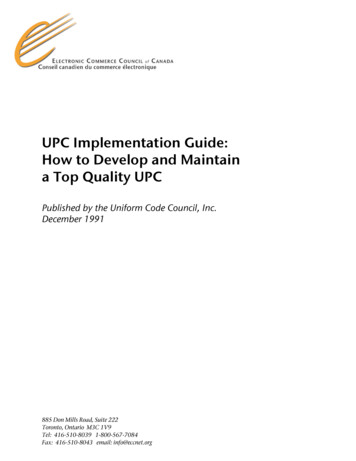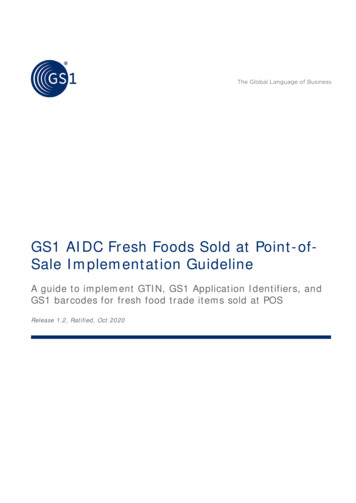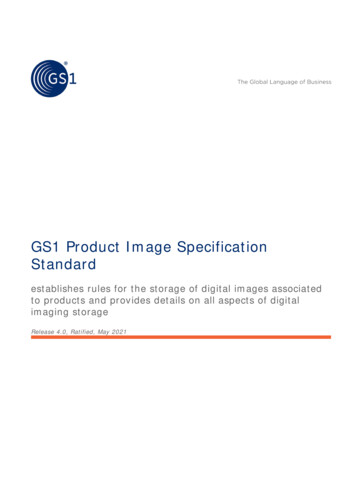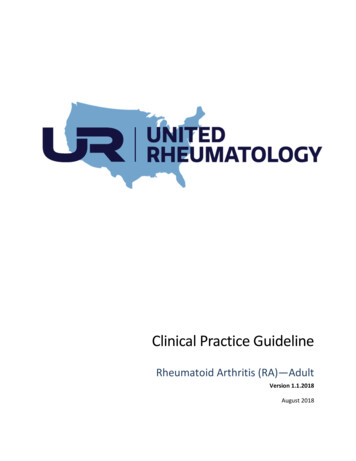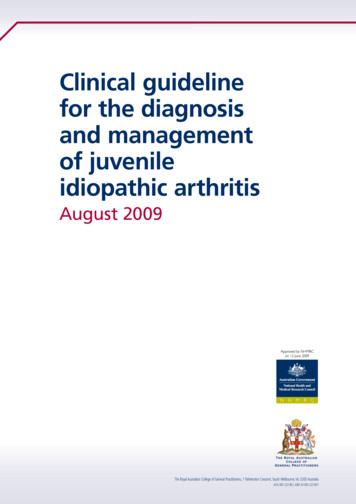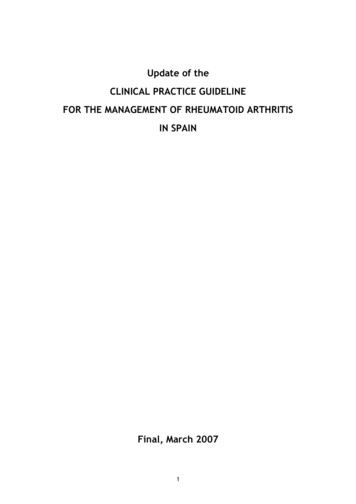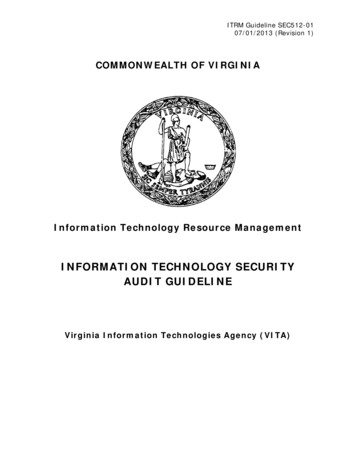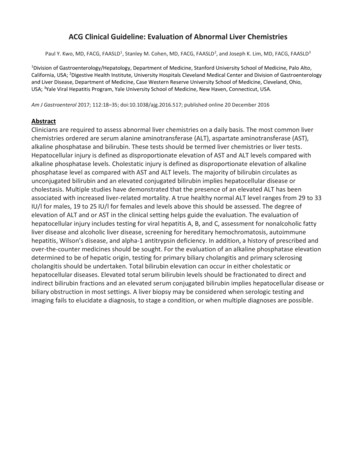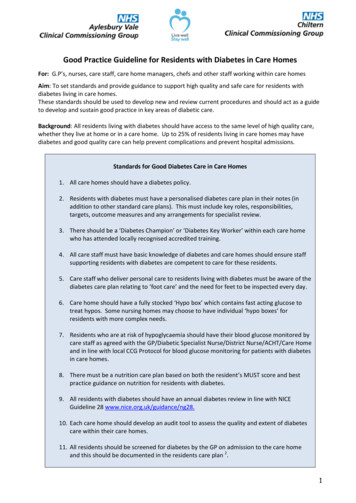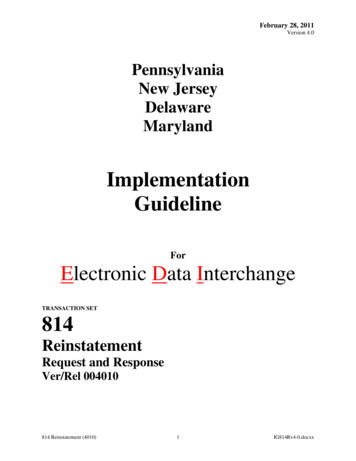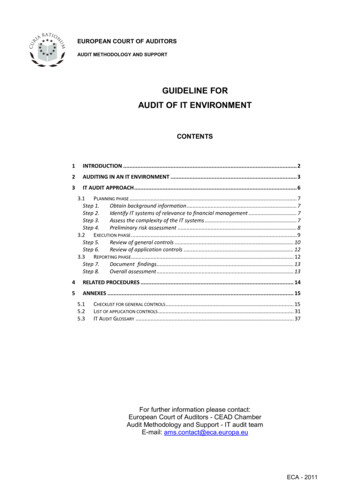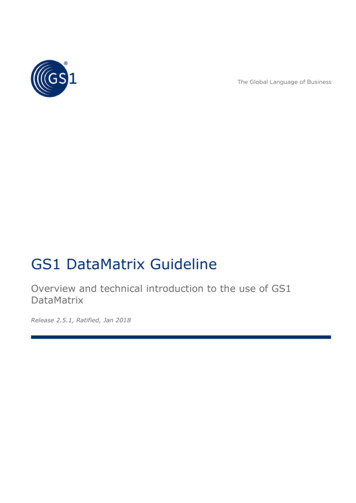
Transcription
GS1 DataMatrix GuidelineOverview and technical introduction to the use of GS1DataMatrixRelease 2.5.1, Ratified, Jan 2018
GS1 DataMatrix GuidelineDocument SummaryDocument ItemCurrent ValueDocument NameGS1 DataMatrix GuidelineDocument DateJan 2018Document Version2.5Document Issue1Document StatusRatifiedDocument DescriptionOverview and technical introduction to the use of GS1 DataMatrixContributorsNameOrganisationLutfi Ilteris OneyGS1 Global OfficeRay DelnickiGS1 USCedric HouletteGS1 FranceJesper Kevin FrankeGS1 DenmarkAlan GormleyGS1 IrelandPeta ScavoneGS1 AustraliaJohn PearceAxiconIlka MachemerGS1 GermanyNeil PiperGS1 UKNaoko MoriGS1 JapanDarryl ZurnSmiths MedicalAndrew HearnGS1 Global OfficeJohn RyuGS1 Global OfficeChuck BissGS1 Global OfficeMarc BenhaimGS1 FranceDavid BuckleyGS1 Global OfficeDoreen DentesGS1 VenezuelaMark Van EeghemGS1 Global OfficeRaman ChhimaGS1 New ZealandSilvério PaixãoGS1 PortugalMichaela HähnGS1 GermanyWang YiGS1 ChinaNaoko MoriGS1 JapanJean-Claude MullerIFAHRelease 2.5.1, Ratified, Jan 2018 2018 GS1 AISBLPage 2 of 60
GS1 DataMatrix GuidelineNameOrganisationMichel OttikerGS1 SwitzerlandNora KaciGS1 Global OfficeHitesh BrahmaGS1 IndiaNevenka ElvinGS1 AustraliaJohn PearceGS1 UKFrank SharkeyGS1 Global OfficeJim WillmottSmiths MedicalLog of ChangesReleaseDate of changeChanged BySummary of Change2.015 Jan 2015Lutfi Ilteris OneyGSMP Publication2.103 Feb 2015Lutfi ilteris Oney, JohnPearceWR 14-2052.2May 2015Lutfi ilteris Oney, CoenJanssen, David BuckleyPublication Editing2.2.1July 2015Valerie HosteApplied new GS1 branding prior to publication2.3May 2016Lutfi ilteris OneyWR 15-315: changes on appendix 1 and 7. Errataedits and community review commentsincorporated.2.4Oct 2016Lutfi ilteris OneyWR 16-258 : changes on section 2.22.5Sep 2017Andrew Hearn, DavidBuckley, Ilka Machemer,Gerald GruberWR 17-145: resolution of Community Reviewcomments including editorial corrections (figurenumbering in section 4) and errata.2.5.1Jan 2018David BuckleyErrata fixes to correct and automate crossreferences, Figure 2-4, etc.DisclaimerGS1 , under its IP Policy, seeks to avoid uncertainty regarding intellectual property claims by requiring the participants inthe Work Group that developed this GS1 DataMatrix Guideline to agree to grant to GS1 members a royalty-free licenceor a RAND licence to Necessary Claims, as that term is defined in the GS1 IP Policy. Furthermore, attention is drawn to thepossibility that an implementation of one or more features of this Specification may be the subject of a patent or otherintellectual property right that does not involve a Necessary Claim. Any such patent or other intellectual property right isnot subject to the licencing obligations of GS1. Moreover, the agreement to grant licences provided under the GS1 IP Policydoes not include IP rights and any claims of third parties who were not participants in the Work Group.Accordingly, GS1 recommends that any organisation developing an implementation designed to be in conformance with thisSpecification should determine whether there are any patents that may encompass a specific implementation that theorganisation is developing in compliance with the Specification and whether a licence under a patent or other intellectualproperty right is needed. Such a determination of a need for licencing should be made in view of the details of the specificsystem designed by the organisation in consultation with their own patent counsel.THIS DOCUMENT IS PROVIDED “AS IS” WITH NO WARRANTIES WHATSOEVER, INCLUDING ANY WARRANTY OFMERCHANTABILITY, NONINFRINGEMENT, FITNESS FOR PARTICULAR PURPOSE, OR ANY WARRANTY OTHER WISE ARISINGOUT OF THIS SPECIFICATION. GS1 disclaims all liability for any damages arising from use or misuse of this Standard,whether special, indirect, consequential, or compensatory damages, and including liability for infringement of anyintellectual property rights, relating to use of information in or reliance upon this document.Release 2.5.1, Ratified, Jan 2018 2018 GS1 AISBLPage 3 of 60
GS1 DataMatrix GuidelineGS1 retains the right to make changes to this document at any time, without notice. GS1 makes no warranty for the use ofthis document and assumes no responsibility for any errors which may appear in the document, nor does it make acommitment to update the information contained herein.GS1 and the GS1 logo are registered trademarks of GS1 AISBL.Release 2.5.1, Ratified, Jan 2018 2018 GS1 AISBLPage 4 of 60
GS1 DataMatrix GuidelineTable of Contents1Introduction to GS1 DataMatrix . 81.1General structure . 81.2Technical characteristics . 81.322.2Size and encoding capabilities . 91.2.3Error detection methods. 131.2.4Reed-Solomon error correction . 13General recommendations for defining Application Standards. 13The encoding structures . 14GS1 element strings . 142.2.1Function 1 Symbol Character (FNC1) . 152.2.2Concatenation . 152.2.3Pre-defined length vs. fixed length element strings . 162.3Human readable interpretation (HRI) . 192.4Symbol location . 202.5Recommendations on encoding for defining Application Standards . 20Reading and decoding GS1 DataMatrix . 223.13.23.34Shape and presentation of the symbol . 81.2.2Encoding data . 142.131.2.1Principles of reading GS1 DataMatrix . 22Scanners for GS1 DataMatrix . 223.2.1Introduction . 223.2.2Selecting a scanner . 23Decoding. 243.3.1The principles of decoding . 243.3.2Transmission of data strings . 24Symbol marking techniques. 264.14.2Basic software functions . 264.1.1Printing device independent software . 264.1.2Software embedded in the printing device. 264.1.3Selecting the right software . 26Symbol marking technologies . 264.2.1Thermal transfer . 274.2.2Inkjet . 274.2.3Laser etch (Direct Part Marking - DPM) . 284.2.4Dot peen (Direct Part Marking - DPM) . 284.3Selecting the right symbol marking technology . 294.4General recommendations for symbol quality . 304.5Colours and contrast . 304.6Verification of symbol (data and print quality) . 314.6.1ISO/IEC 15415 Barcode print quality test specification–2D symbols. 314.6.2Other print quality standards. 344.6.3Possible causes of low grade. 374.6.4The verification process . 384.6.5Selecting a verifier . 40Release 2.5.1, Ratified, Jan 2018 2018 GS1 AISBLPage 5 of 60
GS1 DataMatrix Guideline4.7ARecommendations when developing Application Standards . 40Annexes . 42A.1GS1 size recommendations for symbols using GS1 DataMatrix . 42A.1.1Symbol specification table 6 - Regulated healthcare non-retail consumer trade items notscanned in general distribution . 42A.1.2Symbol specification table 7 - Direct part marking . 42A.1.3Symbol specification table 8 - Trade items scanned in retail pharmacy and generaldistribution or non-retail pharmacy and general distribution . 44A.1.4Symbol specification table 9 - GS1 keys GDTI, GRAI, GIAI and GLN . 44A.1.5Symbol specification table 10 – Regulated healthcare retail consumer trade items notscanned in general distribution . 44A.1.6Symbol specification table 11 – GS1 GSRNs . 45A.2The International Standard ISO/IEC 646 for representation of each character . 45A.3The Extended ASCII Codes . 47A.4Protocol used to encode ASCII in GS1 DataMatrix. 50A.5Structure of codewords used in GS1 DataMatrix . 51A.6Use of GS1 DataMatrix for healthcare products . 51A.7GS1 DataMatrix questions and answers (Informative) . 51BBibliography . 57CGlossary of terms . 58Release 2.5.1, Ratified, Jan 2018 2018 GS1 AISBLPage 6 of 60
GS1 DataMatrix GuidelineForewordThis document aims to facilitate this process by offering detailed information on GS1DataMatrix and its technical characteristics: encoding, printing and reading. This document is theresult of the consolidation of technical knowledge of many users on the Data Matrix technology. Itaims to be a repository of reference information that can support the implementation of GS1DataMatrix in any sector, industry or country. This document is not meant to be all inclusive andis not a replacement for any GS1 standard. The GS1 General Specifications should always bereferred to for all details on GS1 System rules and recommendations.Who should use this document?The intended audience for this document includes GS1 member organisation staff, customers,users of the GS1 System and members of working groups developing application standards andguidelines for GS1 System applications. Please refer to the current version of GS1 GeneralSpecifications for all application standards.This document is not the development standard required to develop hardware and software toencode, decode, scan or print GS1 DataMatrix symbology. The technical detail for this level ofimplementation shall be found in the standard: ISO/IEC 16022, Information technology - Automaticidentification and data capture technologies - Data Matrix barcode symbology specification.This document is not intended as a technical reference for development of imaging (printing andmarking), reading (scanning and decoding) and transmission of data technologies; for those whoneed this level of detail, the standards cited in the bibliography (in particular ISO/IEC 16022) shouldbe implemented.It is assumed that readers of this document are familiar with barcode applications, are able tocreate a barcode and understand the basic principles of automatic identification and data capture.How to use this document?GS1 DataMatrix is primarily intended for implementation in an open system (e.g., a system in whichthe supplier can mark items in the expectation that all trading partners will be able to read andcorrectly interpret the data encoded). In this context, a standard implementation is essential toavoid each partner having to re-label products for different customers and / or at different points ofthe supply chain.This guide is designed to help define standard implementations of GS1 DataMatrix. It is a synthesisof recommendations for encoding, printing and reading GS1 DataMatrix.GS1 has over 40 years’ experience in the definition, maintenance and management of standards forbarcode applications.Release 2.5.1, Ratified, Jan 2018 2018 GS1 AISBLPage 7 of 60
GS1 DataMatrix Guideline1Introduction to GS1 DataMatrixGS1 DataMatrix is a matrix (2D or two-dimensional) barcode which may be printed as a square orrectangular symbol made up of individual dots or squares. This representation is an ordered gridof dark and light dots bordered by a finder pattern. The finder pattern is partly used to specify theorientation and structure of the symbol. The data is encoded using a series of dark or light dotsbased upon a pre-determined size. The size of these dots is known as the X-dimension.Before reading this document one should know the difference between data carrier and datastructure. A data carrier is a graphical representation of data in a machine readable form, used toenable automatic reading of the Element Strings. GS1 DataMatrix is the ISO/IEC recognised andstandardised implementation of the use of Data Matrix. The GS1 DataMatrix is formed by addingFNC1 codeword in the first position of Data Matrix ECC 200 version.1.1General structureGS1 DataMatrix is composed of two separate parts (see figure below): the finder pattern, which isused by the scanner to locate the symbol, and the encoded data itself.The finder pattern defines the shape (square or rectangle), the size, X-dimension and the numberof rows and columns in the symbol. It has a function similar to the Auxiliary Patterns (Start, Stop andCentre patterns) in an EAN/UPC barcode and allows the scanner to identify the symbol as a GS1DataMatrix.The solid dark is called the “L finder pattern”. It is primarily used to determine the size, orientationand distortion of the symbol.The other two sides of the finder pattern are alternating light and dark elements, known as the“Clock Track”. This defines the basic structure of the symbol and can also help determine its size anddistortion.The data is then encoded in a matrix within the Finder pattern. This is a translation into the binaryGS1 DataMatrix symbology characters (numeric or alphanumeric).Figure 1-1 Finder Pattern and the dataFinder patternDataJust like linear (1D) barcodes GS1 DataMatrix has a mandatory Quiet Zone. This is a light areaaround the symbol which must not contain any graphic element which may disrupt reading thebarcode. It has a constant width equal to the X-dimension of the symbol on each of the four sides.Each Data Matrix symbol is made up of number of rows and columns. GS1 DataMatrix always hasan even number of rows and columns. Therefore it always has a light “square” in the upper righthand right corner (circled in the figure above). Obviously, this corner will be dark if the GS1DataMatrix symbol is printed in negative (inverse reflectance printing).1.2Technical characteristics1.2.1Shape and presentation of the symbolWhen implementing GS1 DataMatrix, a choice of symbol form must be made (based uponconfiguration support, available space on the product type, amount of data to encode, theprinting process, etc.). It is possible to encode the same data in two forms of GS1 DataMatrix:Release 2.5.1, Ratified, Jan 2018 2018 GS1 AISBLPage 8 of 60
GS1 DataMatrix GuidelineFigure 1-2 A square form versus a rectangle formSquareRectangleThe square form is the most commonly used and enables the encoding of the largest amount of dataaccording to ISO / IEC 16022 Information technology – Automatic Identification and data capturetechniques – Data Matrix barcode symbology specification.However the rectangular form with its limited height is better suited to some high speed printingtechniques, and to unusual printing spaces.1.2.2Size and encoding capabilitiesGS1 DataMatrix is capable of encoding variable length data. Therefore, the size of the resultingsymbol varies according to the amount of data encoded. Accordingly, this section can approximatethe size of a given GS1 DataMatrix based on this parameter.The figure below is extracted from ISO/IEC 16022 (for the full table see Table 1-1). It provides auseful guide to estimating the size of the symbol but the exact size of the GS1 DataMatrix symboldepends on the exact encoded data. See the figure below for the size and capacity graph.Figure 1-3 Symbol Size vs. Numeric CapacitySymbol Size(Square)Data Capacity (Numeric)Release 2.5.1, Ratified, Jan 2018 2018 GS1 AISBLPage 9 of 60
GS1 DataMatrix GuidelineTable 1-1 Table of Data Matrix symbol attributes (square form)Symbolsize*Data mum datacapacityNumAlpha num.Cap.Cap.% ofCodewordsused 1632122229.
GS1 retains the right to make changes to this document at any time, without notice. GS1 makes no warranty for the use of this document and assumes no responsibility for any errors which may appear in the document, nor does it make
